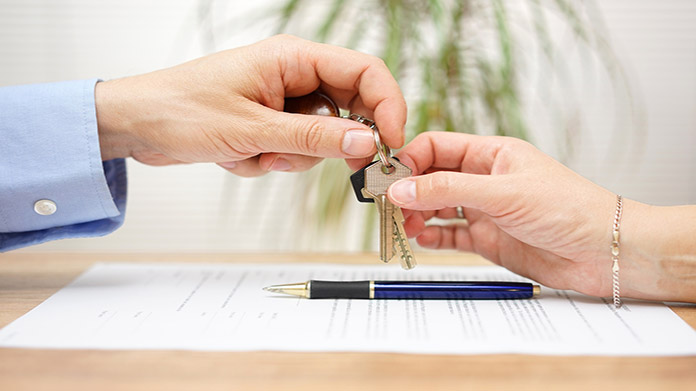
Management of real estate portfolios is crucial because many corporations own large amounts of real estate assets. The portfolio may contain hundreds or even thousands of properties. These assets can be managed in a variety of ways. These include using various computer database systems. These methods are not without their limitations. Most systems don't offer a prudent-due-diligence analysis. They also do not have a benchmark to compare client sites against market comps.
These systems don't give corporations the information they need. Large corporations may own hundreds of properties. Each property has its own expenses and unique beginning and ending dates. Different expenses can rise at different rates. This could also indicate that other expenses are included in the expense calculation but not included.

The invention is an instrument that allows commercial realty managers to optimize the cost of their portfolio. The invention consists of a financial analysis method that projects future expenses for individual leased properties. This method combines rents, property expenses, and other leased property costs over time. These numbers can be compared to market comps, which is the total value of comparable properties. This will produce a per-site cost comparison. These results can then be presented as a benchmark to managers.
This invention also has the unique ability to optimize a geographic region rather than just a single city. As a result, the invention can be applied to other real estate transactions. The invention does not rely on generalized metrics. Instead, it uses eight cycle models to calculate the impact of key investment variables on cyclical cycles. Each model provides an analytical definition for a cycle and insight into one aspect of investment timing.
In addition to financial analysis, the invention will also display the results in a graph format. FIGS. Managers of large companies can see a 50,000 foot view of their portfolios using FIGS.14A-14E. Users can set threshold limits colors to identify properties that need attention. You can also drill down into each Site and use this dashboard to locate individual properties. Combining the above features, this invention can aid corporate managers in properly managing their commercial realty lease portfolios.

Ultimately, the invention is based on an awareness that prior art systems are not sufficiently robust to help commercial real estate managers properly assess their portfolios. They tend to assume that the underlying cost of the leased properties is static. This can lead to a failure to optimize.
FAQ
What are the most frequent handyman repairs that you need to make?
Handymen are often called upon to repair roofs and windows, doors, gutters or siding. They also can install hot water heaters, air conditioning units, electrical systems, sheds, decks, fences, sheds and other items. Handymen can help with home improvement and building projects that are not feasible for DIY homeowners.
What should I choose: hourly or per-project?
Personal preference is the most important factor. Some people prefer to pay an hourly rate so that they know how much their handyman costs. Some prefer to pay for each project, even though they may be doing multiple jobs at once. Either way works fine.
What does the average handyman charge an hour?
A handyman charges between $50-$75 per hour. Most have been doing this for years. Their average work week is about 10 hours. They are well-known and do not need advertising.
They will tend to specialize and establish customer relationships over time.
The key differentiator between them and other contractors is that they're quick, reliable, and cheap.
Most people are familiar with at least two of these guys and feel confident enough to call them when they need support.
Some people are so skilled that they run their own businesses.
What happens to me if a handyman causes damages and I am unhappy with his work.
Notify him immediately if something goes wrong with the project. It is a good idea to keep a detailed log and include photographs. Next, contact your insurance company and file for a claim.
What's the typical time taken to complete a DIY project like this?
The average DIY project takes two to four hours. The complexity and difficulty of the project will determine how long it takes.
Who will handle my handyman project
If you are looking for someone local to perform a one-off job, like replacing a light fixture or fixing a leaky faucet, you won't find a better price than a professional handyman. You might also consider hiring a handyman to do multiple jobs such as installing floor tiles or repairing your roof.
If you are looking for someone who can offer ongoing support, such as regular maintenance, then you probably want to use a handyman service like Handyman Services.
Where are handymen?
There are thousands, if not millions of handymen in America. However, most of them never started out as contractors. Most of them started out as a tradesman. They learned the craft through apprenticeships. Because of this, many have great skills and vast knowledge that can be a huge asset to any company.
Statistics
- “Before the pandemic, 40% of people asked how we could estimate a job when we weren't there,” Rose recalled. (inquirer.com)
- Another estimate was that the market in the United States was $126 billion and was increasing by about 4% annually. (en.wikipedia.org)
- With a strong housing market, the handyman and general maintenance worker industry are expected to grow by nearly 10% in the next decade. (housecallpro.com)
- More than 20% of homes in America have outdoor living spaces, including decks and patios. (mrhandyman.com)
- A franchise was approximately $110,000 with a franchise fee of $14,900, according to a spokesperson for a national handyman franchise. (en.wikipedia.org)
External Links
How To
How to Replace a Broken Tile
Step 1 - Take out the old tiles.
Take out the tiles and place them on a new flooring surface. If you intend to use them, you will want to keep them intact. You can note the parts that are missing or damaged so that you can find replacements.
Step 2 - Select New Tiles
Here are some options for tile repair.
-
You can find a tile replacement that is similar to the one you have just removed.
-
To find the matching piece, use the measurements that you took while removing the tile. This will allow you to quickly find the right size, without having to measure again.
-
You should look for different colors, patterns and textures.
-
Consider what grout you prefer to use. Some prefer a solid color, while others like mixing it up.
-
It is important to ensure that the tile you choose resists moisture.
-
The final thing to consider is the location of the tile. It will save you time and money if you make sure there's enough space for the proper installation.
-
Once you've chosen your tile, order it online or call your local Lowe's store to place your order.
Step 3 - Install the new tiles.
You can install new tiles in the same way you did before. It is important to align them correctly so they fit together properly.
Step 4 - Clean Up
Be sure to vacuum up all crumbs and debris before applying the last layer.
This will prevent dust and dirt from building up between the tiles.
Step 5 – Sand down the floor
After cleaning everything, sand down the floor to remove any loose particles left behind by the previous step.
Step 6 - Close the door
Apply the protective coatings once the floor is smooth. You should wait until this stage as wet paint can stain new tiles.
To protect your floors from stains, you can use "damp-and dry" products.
However, it will not cover all possible problems that may arise after you have installed your tiles. You might want to add an anti-slip coating to the protective layer if there are a lot of children.
Last but not least, be sure to leave the protective sealing on for several weeks before you return to your home.